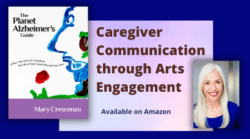So You Think You Can’t Make Art?
 Submitted by Mary Crescenzo
Submitted by Mary Crescenzo
Author, The Planet Alzheimer’s Guide
If your reaction to the title of this article is you saying to yourself, “Nope, I can’t. I don’t have a creative bone in my body,” I have to ask if anyone in your life – parent, sibling, teacher, peer – ever told you “You can’t ________.” (Fill in the blank with draw, paint, sing, dance, act, tell stories, etc.)
Every person who told me they “can’t,” answered this question with, Yes. Sometimes they answered in the affirmative without skipping a beat. Other times they were silent for a moment, hesitant and then, with a faraway look, replied, “Yes, it was my ________!” (If you answered Yes, fill in the blank with that person’s name and know that that person was wrong!)
As a master teaching artist and a pioneer in Arts Engagement for decades with older adults and those with Alzheimer’s/dementia and their caregivers, I have seen and heard this reaction in the face and response of people of all ages, from children to older adults and from all kinds of people including those who are well, frail or with special needs.
We All Have the Creative Spirit
This is what I know, for certain. The creative spirit lives in all of us. From Day One to some of our last days. As powerful as it is, it can be damaged by another human being with just those two words – “You can’t.”
Whether it’s an order from another to not pursue your dream, or an unsolicited opinion from an uninformed source, “I can’t” will echo in your head every time you even think about using your innate ability to create something from nothing; something, that is as pleasurable in the process of doing as is the finished project. Something that’s your own.
Yes, We Do!
Do you know who is not or no longer impressed with the “You can’t” scourge? A person living with Alzheimer’s/dementia. Since as early as the late 1960’s, I’ve engaged with persons with this disorder using painting, drawing, music, dance, movement, poetry and storytelling or a combination of the above. That is, when I could persuade a care facility or an Activities Director that this work could enrich the personal lives of those in their care.
Persons living with Alzheimer’s/dementia may lose their memories, their inhibitions and their sense of time, but they haven’t lost their ability to creativity express themselves. I have found that at various stages of this disorder, with open-ended direction, most can focus and engage with the art and others.
Because if you don’t believe you can be creative, you won’t believe the possibility that a person for whom you care can be.
With a little encouragement they can teach us, with or without words, that “I can’t” is not the only option. This article is not only about persons living with this disorder, it’s about you, as a caregiver. Because if you don’t believe you can be creative, you won’t believe the possibility that a person for whom you care can be.
Writing as Respite
In my how-to book, I share with the reader the various ways you can use Arts Engagement with your loved one or the person with whom you are working. Chapter eight is dedicated to caregivers and how they can find through the art of creative writing, a place of respite, relaxation and revelation.
Whether you only have a five minute break, even if you’ve never thought of yourself as a writer, you can express your feelings and find cathartic release through the use of this journal-like, literary art form. Perhaps this article will pique your interest in all the various art forms you can do.
Art is a common denominator in us all. It doesn’t matter if you are a famous artist a person of extraordinary artistic talent, a person who just wants to explore the art experience for your own enjoyment, a person with a disorder or a specific need, or even if you are a person with Alzheimer’s/dementia or a caregiver.
Whether you explore art with another person or even on your own, I trust that you will discover the joy and relaxation that making art can bring!
A Plan Takes Shape
So next time you don’t know what else to do when visiting or caring for your loved one, once the daily routines are done, once the silence or stress become overwhelming, think to yourself, I can, he/she can, we can do a simple, open-ended, art experience.
Try and see what happens.
You may be surprised what this kind of alternative, complementary connection and communication method through the arts can bring forth in you and the person you care for.
Please note, an art experience is not an art activity. There is a difference.
Art Activity
When you do an art activity, you’re active but it often is directed and generic in its essence – less focused on your self-expression and direction, and more on what you are trying to accomplish.
Art Experience
When you engage in an art experience, it welcomes an open-ended suggestion to get you off your feet, so to speak. An art experience frees you (or the person you are caring for) to express yourself in your unique way.
Many, Many Options!
The arts are as varied as types of sports. In art, the type of art is referred to as an art discipline, art medium or art form. Let’s look at some art forms you may want to try as an individual or as a caregiver. These are just a sampling of what is out there for you!
- Visual Art: Painting with watercolor or acrylic paints, drawing with pen and ink, felt tip markers, pencil, charcoal; collage, photography, computer art; sculpture – stone, clay, wood, found objects.
- Performing Arts: Instrumental, vocal, theatre, storytelling, poetry, spoken word, dance.
- Literary Arts: Writing – stories, poetry, fiction, nonfiction, creative nonfiction, essay, plays.
- Artisan Crafts: Ceramics, pottery, blown glass, woodworking; sewing of clothes, quilts, pillows, wall hangings; embroidery, knitting, crocheting.
When you choose an art form, remember that you can create from your imagination or from observation. Your creation can be representational or abstract. You can create art by mixing different art forms in one artwork – this is called, mixed media. With such a myriad of art disciplines for you to dive into, you can make the choice of which you’d like to explore.
Let your creative spirit soar!
Many years ago, when I started my work as a teaching artist, my mission was to bring art accessibility to everyone and to unlikely places. When I began my work exploring the use of art with persons living with Alzheimer’s/dementia, my head and heart knew that I was forging an even broader path. I realized that those living with this disorder, just like all of us, have an inherent need for creative self-expression. In honor of that innate ability to create, my slogan continues to be, “Let your creative spirit soar!”
Mary Crescenzo

Mary Crescenzo is the author of The Planet Alzheimer’s Guide: 8 Ways the Arts Can Transform the Life of Your Loved One and Your Own, a speaker on the subject or Arts & Alzheimer’s, and a member of AlzAuthors.
Visit Mary Crescenzo on Dementia Map or on her website!


